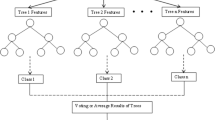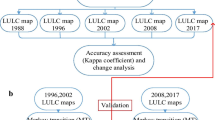Abstract
Geographical Information System (GIS) and remote sensing have become necessary tools in finding out land use land cover (LULC) change integrated with their associated driving factors. The utilization of satellite imagery made it easy to interpret the highly urbanized Warangal City that has experienced a lot of change in LULC during the last few decades. This paper discusses the ability of the integration of cellular automata (CA) and Markov chain–based 2D land use simulation module conjunction with GIS techniques. Markov chain algorithm is used for calibration and optimization by considering LULC of appropriate set of images for the years 2004, 2006, and 2018. Transitional change in LULC from one class to another is simulated using an artificial neural network (ANN) while cellular automata simulation is carried out to predict the plausible future LULC for the year 2052 after validating the model using the LULC of the year 2018. Analysis of the multi-temporal LULC maps indicated that the biophysical and socio-economic factors have greatly influenced the rise in built up while a decrease in agriculture in the year 2052. In conclusion, this technique is a powerful tool for monitoring and modeling change in land cover. Further suggestions for government officials are provided for an effective policymaking and to protect the land resource.







Similar content being viewed by others
References
Adade B, Oppelt N (2019) Land-use/land-cover change analysis and urban growth modelling in the Greater Accra Metropolitan Area (GAMA), Ghana. Urban Sci 3(1):26
Al-sharif AAA, Pradhan B (2014) Monitoring and predicting land use change in Tripoli Metropolitan City using an integrated Markov chain and cellular automata models in GIS. Arab J Geosci 7(10):4291–4301
Anderson JR et al (1976) A land use and land cover classification system for use with remote sensor data. Geological Survey Professional Paper No. 964, U.S. Government Printing Office, Washington DC
Gharbia SS, Alfatah SA, Gill L, Johnston P, Pilla F (2016) Land use scenarios and projections simulation using an integrated GIS cellular automata algorithms. Model Earth Syst Environ 2:151
Ghosh P, Mukhopadhyay A, Chanda A, Mondal P, Akhand A, Mukherjee S, Hazra S (2017) Application of cellular automata and Markov-chain model in geospatial environmental modeling- a review. Remote Sens Appl Soc Environ 5:64–77
Halmy MWA, Gessler PE, Hicke JA, Salem BB (2015) Land use/land cover change detection and prediction in the northwestern coastal desert of Egypt using Markov-CA. Appl Geogr 63:101–112
Hamad R, Kolo K, Balzter H (2018) Land cover changes induced by demining operations in Halgurd-Sakran National Park in the Kurdistan region of Iraq. Sustainability 10:2422
Mallick J, Kant Y, Bharath BD (2008) Estimation of land surface temperature over Delhi using Landsat-7 ETM+. J Indian Geophys Union 12(3):131–140
Muhlestein KN (2008) Land use land cover change analysis of Maverick County Texas along the US Mexico border. EES 5053 Remote Sensing, University of Texas at San Antonio. Environmental Science and Engineering PhD Program
Naboureh A, Moghaddam MHR, Feizizadeh B, Blaschke T (2017) An integrated object-based image analysis and CA-Markov model approach for modeling land use/land cover trends in the Sarab plain. Arab J Geosci 10(12):259
Reis S (2008) Analyzing land use/land cover changes using remote sensing and GIS in Rize, North-East Turkey. Sensors 8:6188–6202
Roy PS, Roy A (2010) Land use and land cover change in India: a remote sensing and GIS perspective. J Indian Inst Sci 90:489–502
Yesserie AG (2009) Spatio-temporal land use/land cover changes analysis and monitoring in the Valencia municipality, Spain. Dissertation for Award of MSc Degree at Universitat Jaume I, Castellón, Spain, p 69
Yu W, Zang S, Wu C, Liu W, Na X (2011) Analyzing and modeling land use land cover change (LUCC) in the Daqing City, China. Appl Geogr 31(2):600–608 http://www.qgis.org/en/site/forusers/download.html
Author information
Authors and Affiliations
Corresponding author
Additional information
Highlights
• Spatiotemporal analysis of the land use land cover
• Calibration and optimization is carried out using a Markov chain model
• The artificial neural network is used to estimate the transition in land use classes
• Cellular Automata simulation is carried out to predict the future (2052) LULC.
Rights and permissions
About this article
Cite this article
Aneesha Satya, B., Shashi, M. & Deva, P. Future land use land cover scenario simulation using open source GIS for the city of Warangal, Telangana, India. Appl Geomat 12, 281–290 (2020). https://doi.org/10.1007/s12518-020-00298-4
Received:
Accepted:
Published:
Issue Date:
DOI: https://doi.org/10.1007/s12518-020-00298-4




